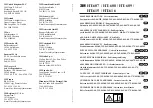
16
ridewithinyourabilities
average center strip permits adequate
traction to ride on safely. You can
operate to the left or right of the grease
strip and still be within the center third
of the traffic lane. Avoid riding on big
buildups of oil and grease usually found
at busy intersections or tollbooths.
Experienced riders rely on their own
best judgment and instincts. One
absolute, however, is to avoid riding in
another vehicle’s blind spot.
Following Another Vehicle
“Following too closely” is a factor in
crashes involving motorcyclists. In traffic,
motorcycles need as much distance
to stop as cars. Normally,
a minimum
of two seconds
distance should be
maintained behind the vehicle ahead.
To gauge your following distance:
• Pick out a marker,
such as a
pavement marking or lamppost, on
or near the road ahead.
• When the rear bumper
of the
vehicle ahead passes the marker,
count off the seconds: “one-
thousand-one, one-thousand-two.”
• If you reach the marker
before
you reach “two,” you are following
too closely.
A two-second following distance
leaves a minimum amount of space to
stop or swerve if the driver ahead stops
suddenly. It also permits a better view of
potholes and other hazards in the road.
A larger cushion of space is needed
if your motorcycle will take longer
than normal to stop. If the pavement
is slippery, if you cannot see through
the vehicle ahead, or if traffic is heavy
and someone may squeeze in front of
you, open up a three-second or more
following distance.
Keep well behind the vehicle ahead
even when you are stopped. This will
make it easier to get out of the way
if someone bears down on you from
behind. It will also give you a cushion of
space if the vehicle ahead starts to back
up for some reason.
following
Summary of Contents for 16th Edition
Page 54: ...54 ...
Page 58: ......
Page 60: ...Motorcycle Safety Foundation 2 Jenner Suite 150 Irvine CA 92618 3806 www msf usa org ...
















































